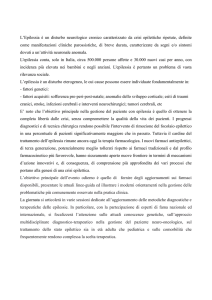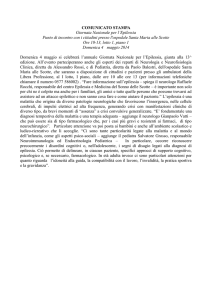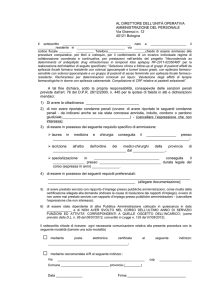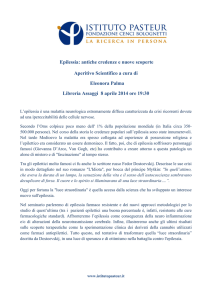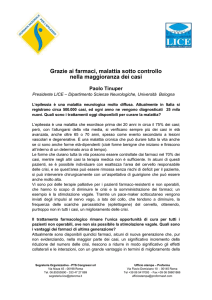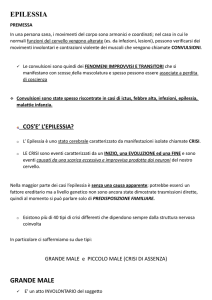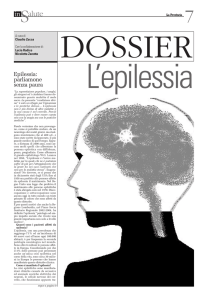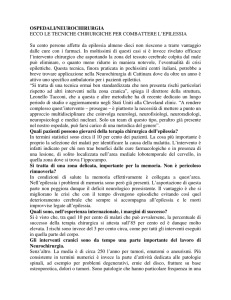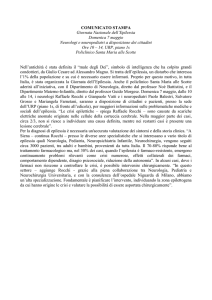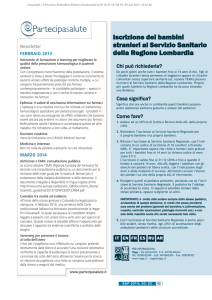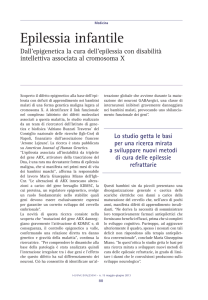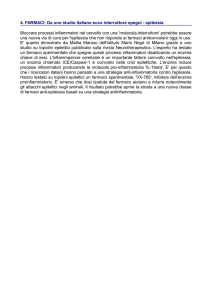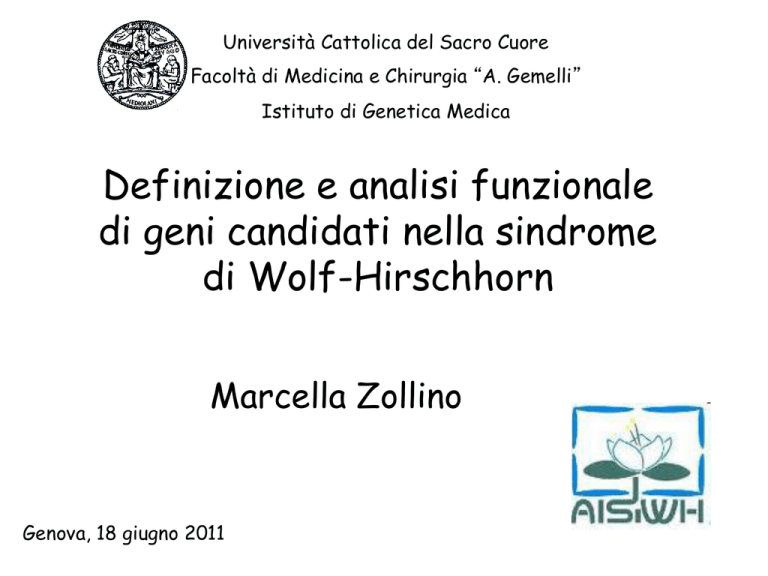
Università Cattolica del Sacro Cuore
Facoltà di Medicina e Chirurgia “A. Gemelli”
Istituto di Genetica Medica
Definizione e analisi funzionale
di geni candidati nella sindrome
di Wolf-Hirschhorn
Marcella Zollino
Genova, 18 giugno 2011
WHS: personal observations
n 87 WHS patients (36 M/51 F)
2 months- 28 ys
4p deletion size: 1.9 Mb - 29 Mb
n 6 patients with 4p deletion not causative of WHS
- del 4p terminal < 1,6 Mb (3)
- del 4p interstitial
(3)
WHSCR
4p16.3
(Wright et al 1997)
Rauch, 2001
WHSC2 WHSC1 LETM1 cen 1.9 Mb 1.8 Mb 1.5 Mb // S166 S3327 S98 FGFR3 S168 S96 58b6 158b1 96a2 190b4 75b9 pC385.12 pC678 174g8 27h9 19h1 184d6 184O23 WHSCR
tel LETM1
WHSC2
cen
3.0
WHSC1
tel
FGFR3
2.5
2.0
165 kb
1.5
0.5
1.0
WHSCR
(Zollino et al. 2003, patient MG)
(Rodriguez et al. 2005, patient 97)
- Facies
- Ritardo di crescita grave
- RM
- Epilessia
1.9 Mb
1.9 Mb
4p
WHSCR-2
(Zollino et al, Am J Hum Genet, 2003)
t(4p;12p)
4p16.3
Mother of case 012
patient MG + Rodriguez’s patient (tot 2)
WHSC1
cen
LETM1
1.9 Mb
S166
58b6
1.8 Mb
//
S3327
158b1
174g8
96a2
27h9
tel
S98 FGFR3 S168 S96
190b4
19h1
1.5 Mb
75b9
pC385.12
184d6 184O23
WHSCR-2
pC678
REARRANGEMENTS
- Familial (translocations) (10)
T
(
- de novo
12 %
(t (4p;22q)
t (4p;10q)
t (4p;8p)
t (4p;12p)
(75)
88 %
WHS: de novo rearrangements (N 52) analyzed with all telomeres or
a-CGH
Type of the rearrangement
No
%
Isolated deletions
37
72
Unbalanced translocations
11
20
Dup/del 4p
3
6
der(4)(4qter→q32::4p15.3→qter)
1
2
t(4p;8p)
(6)
t(4p;7p)
t(4p;11p)
t(4p;20q)
t(4p;12p)
t(4p;Dp/Gp)
WHS: parental origin of de novo rearrangements
Maternal
t(4p;8p)
5
t(4p;7p)
1
t(4p;20q)
1
del(4p) interstitial
1
del(4p) terminala
2
Paternal
del(4p) terminal
a
10/44
(23%)
34/44
(77%)
29
del(4p) interstitial
2
t(4p;11p)
1
t(4p;acro p-arm)
1
der(4)(4qter→q32::4p15.3→qter)
1
a 1.5 Mb deletion, preserving the WHSCR-2, was detected in the mother of patient 12.
WHS
n Partial 4p deletion (4p16.3)
n Clinical signs
- “Greek warrior helmet profile”
- MR
- Pre- and postnatal growth retardation
- Microcephaly
- CHD
- Midline defects
cleft palate
hypospadias
agenesis of corpus callosum
- Renal abnormalities
- Skeletal anomalies
- Seizures
S3327
-
-
-
-
-
-
-
-
1,9
S43
33c6
2,25
247f6
2,8
S180
21f12
3,3
S81
228a7
3,7
MSX-1
4,9
RP115,6-5,9
524D9
RP117-7,2
367J11
RP118,6-8,7
358C18
RP119
423D16
RP119.4
751L19
RP1113
731E20
RP1114.1
358H2
RP1114.6
81L15
RP1115.4
565F20
-
-
-
-
-
-
-
-
-
-
-
1,8
190b4
t(4p;3p) mat
-
t(4;13) (p16.;q33)
mat
-
145
t(4;13) (p16.1;p11)
mat
-
50
t(4;D/G)(p16.2;p11)
de novo
-
25
t(4;20)(p16.2; q13.3)
de novo
-
118
t(4;11) (p16.1;q23.3)
pat
-
7
t(4;11) (p16.1;q25)
mat
-
116
t(4;11)(p16.1;p15.5)
de novo
-
81
t(4;10) (p16.3;p15)
mat
-
24
t(4;7)(p16.3;p22.2)
mat
-
Patients
127
43
t(4;7) (p16.3;p23)
de novo
87
t(4;8) (p16.3;p23)
de novo
74
-
S182
MSX1
52
t(4;8) (p16.3;p23)
de novo
pC678
S98
pC385.1
FGFR3
2
140
t(4 ;8)( p16.1;p23)
de novo
S96
48
t(4;8)(p16.1;p23) pat
CD2
40
t(4;8)(p16.1;p23)
de novo
S90
39
t(4;8)(p16.1;p23)
de novo
Tel
30
t(4;8)(p16.1;p23)
de novo
Probes
S3359
Distance from 4pter (Mb)
Locus
Unbalanced translocations (familial or de novo):tot=18
-
-
-
-
-
-
+
+
-
-
-
-
-
-
-
-
-
-
-
-
-
+
+
+
-
+
+
-
-
-
+
+
+
+
-
-
-
-
-
-
-
-
-
-
-
-
+
-
-
+
+
+
+
+
-
-
+
+
+
+
+
+
-
-
-
+
+
+
+
-
+
-
-
-
-
+
+
-
+
-
+
+
+
Patients No
Probes
pC847.351
CD2
pC678
pC385.12
190b4
19h1
108f12
33c6
161c2
79f5
212a9
185f6
247f6
21f12
228a7
MSX1
RP11-524D9
RP11-367J11
RP11-358C18
RP11-423D16
RP11-751L19
RP11-17I9
RP11-270I3
RP11-1J7
RP11-3M2
RP11-731E20
RP11-356H2
RP11-81L15
RP11-469O6
RP11-565F20
RP11-332D24
RP11-481K22
RP11-778B12
RP11-497E20
RP11-390C19
Distance
from
4pter
(Mb)
0,15
0,25
1,2
1,8
1,95
2
2,2
2,3
2,35
2,5
2,5
2,6
2,9
3,4
3,7
4,9
5,9
7,2
8,6
9
9,4
9,7
10,8
11,6
12,6
13
14,1
14,6
15
15,4
20
22
25,4
27
29,5
37
1
80
-
-
-
-
-
2
3
4
5
36
41
45
89
-
18
42
73
128
139
32
78
82
-
-
-
+
-
-
-
-
-
-
-
-
-
-
-
-
112
111
33
131
59
-
-
-
-
-
-
-
-
-
-
-
-
6
11
22
117
10
35
120
20
31
86
124
-
-
-
-
-
8
9
85
88
91
119
-
-
-
-
-
-
-
-
-
-
+
+
+
+
+
+
+
+
+
+
+
+
+
+
+
+
+
+
-
+
+
+
-
-
+
+
+
+
+
+
+
+
+
+
+
+
+
+
+
+
+
+
+
+
+
44
98
12
13
+
+
-
-
-
-
-
-
-
-
-
-
-
+
-
-
-
-
-
-
-
-
92
26
46
77
103
115
+
+
+
-
+
-
+
+
+
+
+
+
+
+
-
14
15
75
MG
97
-
+
+
+
+
+
+
+
WHS
Clinical categories
The “classical” phenotype
Large 4p deletion
(6-18 Mb)
Characteristic face
Severe MR
Severe growth delay
Seizures
Microcephaly
CHD
Midline defects
Renal anomalies
Colobomas
Poor motor skills (walking
after 6-8 ys)
§ Language limited to a few
words or absent
§
§
§
§
§
§
§
§
§
§
The “mild” phenotype
4p del < 3.5 Mb
§
§
§
§
§
§
§
Characteristic face
Seizures
Growth delay
Mild MR
Cleft palate
Independent walking: 2-3 ys
Language can be fluent
OFC can be normal
WHS: small 4p deletions
2.5 Mb
2.4 Mb
2.2 Mb
1.9 Mb
WHS: clinical categories
§ Classical
§ Mild
§ Severe: WHS ?
70 %
23 %
7%
Severe
Mild
Classical
WHS
• Eterogeneità dell’ampiezza di delezione
1.9-3.5 Mb “mild form”
5-18 Mb “classical form”
22-25 Mb “atypical form”
•
Core phenotype
- facies caratteristica
- RM
- ritardo di crescita (grave)
- epilessia
• Patogenesi multigenica
WHS
Factors for phenotypic variability
1) Extent of the 4p deletion
3.5
< 3.5 Mb
§ No major malformations (limited to cleft palate)
§ Milder MR
2) Complex rearrangements
~ 30 % of all de novo anomalies
3.5
Factors predictive of prognosis
n Extent of the 4p deletion
“cut-off” 3.5 Mb
n Double chromosome imbalance
n Seizures: independent prognostic factor
WHS: IL FENOTIPO BASALE
• Ritardo psicomotorio
• Epilessia
• Ritardo di crescita
• Caratteristiche facciali peculiari
WHS: geni candidati
• WHSC1: ritardo di crescita (in parte)
RM?
• LETM1: epilessia
Non ci sono geni candidati per il ritardo di crescita
Linee di ricerca
1)
Analisi di correlazione genotipo-fenotipo
ricerca di geni nuovi candidati
2) Studio dei meccanismi alla base dell’epilessia
- effetti dell’aploinsufficienza di LETM1 in diverse linee cellulari
- analisi di espressione di tutti i geni (vie dell’epilessia)
- individuare meccanismi molecolari modulabili farmacologicamente
Array-CGH
Delezioni atipiche
Geni candidati
LETM1
WHSC2
cen
3.0
WHSC1
tel
FGFR3
2.5
2.0
165 kb
1.5
1.0
WHSCR
Delezione di
WHSC1
- Facies?
- Ritardo di crescita +/- RM lieve
- NO convulsioni
Rauch et al. 2001 Am J Med Genet
0.5
4p
LETM1
WHSC2
cen
WHSC1
tel
FGFR3
3.0
2.5
2.0
WHSCR
(Zollino et al. 2003, patient MG)
1.5
0.5
1.0
300-600 kb
WHSCR-2
(Rodriguez et al. 2005, patient 97)
(Faravelli et al. 2007)
- Facies?
- NO ritardo di crescita
- Convulsioni febbrili (pochi episodi)
1.9 Mb
1.9 Mb
1.5 Mb
4p
LETM1
WHSC2
cen
3.0
WHSC1
tel
FGFR3
2.5
2.0
WHSCR
(Zollino et al. 2003, patient MG)
1.5
0.5
1.0
WHSCR-2
1.9 Mb
1.9 Mb
(Rodriguez et al. 2005, patient 97)
1.5 Mb
(Faravelli et al. 2007)
1.4 Mb
(Maas et al. 2008, patient 1)
- No facies
- Ritardo crescita lieve
- RM lieve
- Epilessia
4p
LETM1
WHSC2
cen
WHSC1
tel
FGFR3
3.0
2.5
2.0
WHSCR
(Zollino et al. 2003, patient MG)
(Rodriguez et al. 2005, patient 97)
(Faravelli et al. 2007)
(Maas et al. 2008, patient 1)
1.5
WHSCR-2
1.9 Mb
1.9 Mb
1.5 Mb
1.4 Mb
0.4 Mb
(Van Buggenhout et al. 2004)
(Izumi et al. 2009)
4p
0.5
1.0
1.3 Mb
- Facies
- No facies
- Ritardo crescita
- Ritardo crescita lieve
- RM
- RM lieve
- Epilessia
- Epilessia
LETM1
WHSC2
cen
3.0
WHSC1
tel
FGFR3
2.5
2.0
WHSCR
(Zollino et al. 2003, patient MG)
1.5
WHSCR-2
4p
0.5
1.0
1.9 Mb
1.9 Mb
(Rodriguez et al. 2005, patient 97)
1.5 Mb
(Faravelli et al. 2007)
1.4 Mb
(Maas et al. 2008, patient 1)
0.4 Mb
(Van Buggenhout et al. 2004)
1.3 Mb
(Izumi et al. 2009)
1.2 Mb
Present case
Human Genome CGH microarray 244K, Agilent Technologies
LETM1
WHSC2
cen
3.0
WHSC1
tel
FGFR3
2.5
2.0
WHSCR
1.2 Mb
1.5
1.0
0.5
WHSCR-2
Present case
- Facies?
- Ritardo di crescita +/- (basso peso, statura normale)
- RM lieve
- Epilessia
4p
1)
Analisi di correlazione genotipo-fenotipo
Concetto di regione critica rivisitato
1.9 Mb – 0.4 Mb
I geni candidati sono verosimilmente
interspersi in una regione di 1.5 Mb
WHS: patogenesi multigenica
•
Facies caratteristica: WHSC1 + altri geni distali (?)
• Ritardo di crescita: WHSC1 + altri geni distali (?)
• Ritardo psicomotorio: multigenico, ma influenzato dall’epilessia
• Epilessia: LETM1 + altri geni distali (?)
WHSC2: non più gene candidato
MODELLI MURINI
MODELLI ANIMALI (1)
delezioni di ampiezza diversa
della regione critica:
- ritardo crescita
- fronte ampia
- ipertelorismo
- -convulsioni
Näf et al., 2001, Hum Mol Genet
MODELLI ANIMALI (2)
WHSC1
piccoli
problemi respiratori
difetti linea mediana
difetti cranio-facciali
Nimura et al., 2009, Nature
LETM1
principale gene candidato per epilessia
MODELLI ANIMALI (5)
CG4589 ortologo LETM1 ---> DmLETM1
• MORFOLOGIA MITOCONDRIALE
Prima RNAi
• SOPRAVVIVENZA
Dopo RNAi
McQuibban et al., 2010, Hum Mol Genet
• RITARDO DI CRESCITA
Down-regulation DmLETM1
ubiquitaria
Down-regulation DmLETM1
nel tessuto muscolare
letale allo stadio larvale
letale allo stadio di pupa (90%)
McQuibban et al., 2010, Hum Mol Genet
w.t.
Down-regulation DmLETM1
nell’occhio
- mitocondri rigonfi
- matrice elettron-trasparente
- creste mitocondriali frammentate
McQuibban et al., 2010, Hum Mol Genet
MODELLI ANIMALI (6)
w.t.
w.t.
C: mitocondri rigonfi quando Letm1 è
inattivo
Hasegawa et al., 2007, Hum Mol Genet.
• Epilessia
LETM1
• Ritardo di crescita
LETM1
Dimmer et al., 2008, Hum Mol Genet
- Omeostasi del K+
La nigericina contrasta le
alterazioni mitocondriali indotte
dallo ionoforo valinomicina
Dimmer et al., 2008, Hum Mol Genet
LETM1
1) Aploinsufficienza
2) Specificità tissutale
3) Anomalie morfo-strutturali dei mitocondri
4) Anomalie funzionali dei mitocondri
5) Analisi di rescue in vitro (solo dopo l’ottenimento di un parametro
oggettivo e riproducibile)
ALLESTIMENTO DI LINEE CELLULARI
• Colture in sospensione di linfociti B immortalizzati con EBV (già disponibili)
• Biopsia di cute e di muscolo in 3 individui con WHS e in 3 controlli sani:
- allestimento e crioconservazione di colture primarie di fibroblasti,
- allestimento e crioconservazione di colture primarie di mioblasti.
F.A.
R.A.
P.D.
Quantificazione relativa del trascritto LETM1
LINFOBLASTI
1.2
1
0.8
0.6
0.4
0.2
0
1
FIBROBLASTI
1.2
M IOBLASTI
1.2
1
1
0.8
0.8
0.6
0.6
0.4
0.4
0.2
0.2
0
0
1
1
Quantificazione relativa della proteina LETM1
in mioblasti
Controls
LETM1
Actina
WHS Patients
LETM1
• espressione biallelica
• gene dose-sensibile
• aploinsufficienza
Control
Microscopia elettronica
linfoblasti
WHS Patients
Microscopia elettronica mioblasti
Preliminary results
Changes in mitochondrial TMRM
fluorescence in myoblasts from
Wolf-Hirschhorn syndrome
(WHS) patients
• Patogenesi mitocondriale dell’epilessia
• Mdm38p, l’omologo di LETM1 nel lievito, è responsabile della morfologia
e della funzione mitocondriale: la sua delezione causa rigonfiamento dei
mitocondri e alterazione delle creste interne
• Mdm38p-LETM1 regolazione dello scambio K+/H+ : la perdita di
funzione causa un incremento dei livelli di K+ all’interno dei
mitocondri, con conseguente accumulo di acqua.
280411_control_DE_P7_1st
280411_Letm1_FA_P4_2nd
Min-massimo luminosità : 147-573
Intensità lampada 6.85%
200411_Letm1_FA_P3_3rd
Min-massimo luminosità:170-1139
Intensità lampada 6.85%
200411_Letm1_FA_P3_3rd
200411_Letm1_FA_P3_4rd
Min-massimo luminosità:168-874
Intensità lampada 6.85%
200411_Letm1_FA_P3_4rd
Min-massimo luminosità:143-457
Intensità lampada 6.85%
1.6x
200411_Letm1_FA_P3_4rd
Intensità luce:169-1152
Intensità lampada
6.85%
200411_Letm1_FA_P3_4rd
200411_Letm1_FA_P3_5th
Min-massimo luminosità:
167-982
Intensità lampada 6.85%
+ Oligo 4µM
+ Oligo 4µM
+ FCCP 4µM
280411_Letm1_FA_P4_2nd
Valino
90nM
FCCP
4µM
Depolarization
TMRM fluorescence, % of the initial value
120
100
80
60
40
20
0
0
20
Time(min)
40
60
280411_control_DE_P7_3rd
Valino
9nM
FCCP
4µM
TMRM fluorescence, % of the initial value
120
100
80
60
40
20
0
0
10
Time(min)
20
30
280411_control_DE_P7_4rd
Valino
45pM
TMRM fluorescence, % of the initial value
160
140
120
100
80
60
40
20
0
0
10
Time(min)
20
30
40
Time 0’
Time 16’
Val
Time 18’
+45pM
Time 20’
Time 20’
Time 22’
Time 24’
Time 30’
280411_control_DE_P7_5th
* = +9 pM
Valino
9pM
* *
*
*
*
*
*
+0.9nM
TMRM fluorescence, % of the initial value
120
100
80
60
40
20
0
0
10
20
30
40
50
60
70
80
90
Time(min)
FROM 36 TO 63pM THERE IS DEPOLARIZATION IN THE CONTROL CELLS
290411_Letm1_FA_P4_2nd
90pM
45pM
TMRM fluorescence, % of the initial value
180
Valino
36pM
160
140
120
100
80
60
40
depolarization
20
0
0
10
20
30
40
50
Time(min)
60
70
80
90
100 110 120 130 140
290411_Letm1_FA_P4_3rd
Valino
36pM
* = +9 pM
TMRM fluorescence, % of the initial value
120
*
*
100
*
*
*
80
60
40
20
0
0
10
20
30
40
50
Time(min)
60
70
80
90
100 110 120 130
110511_CTR_DE_P8_1st
72pM
Valino
45pM
140
TMRM fluorescence, % of the initial value
126pM
99pM
153pM
180pM
120
100
900nM
80
60
40
20
0
0
20
40
60
Time(min)
80
100
120
110511_Letm1_FA_P5_2nd
TMRM fluorescence, % of the initial value
140
Valino
45pM
72pM
99pM
126pM
120
153pM
180pM
100
900nM
80
60
40
20
0
0
20
40
60
Time(min)
80
100
120
18’
28’
270pM
180pM
90pM
42’
48’
Valino
90pM
TMRM fluorescence, % of the initial value
140
180pM
270pM
360pM
360pM
FCCP 4µM
120
100
80
FCCP
60
40
20
0
CTR_DE_P8_3rd
0
20
Time(min)
40
60
120511_Letm1_FA_P5_2nd
22’
14’
12’
Val
44’
270pM
52’
Valino
90pM
180pM
270pM
360pM
140
TMRM fluorescence, % of the initial value
90pM
180pM
90pM
90pM
34’
120
100
360pM
FCCP
80
60
40
FCCP
20
0
0
20
40
Time(min)
60
80
Mitochondrial morphology
• Some mitochondria of the patient cells appeared fragmented,
round and smaller than their counterpart in cells from
healthy donors
•
After addition of very low concentrations of the K+
ionophore valinomycin mitochondria in the patient cells
appeared ‘swollen’ unlike those of control cells: we
conclude that the electrophoretic K+ influx rate exceeds the
rate of K+ release, probably because the K+-H+ exchanger is
not working adequately. K+ uptake is compensated by H+
extrusion, driving in turn the accumulation of Pi, so that the
accumulated species is probably K-Pi, wich is eventually
responsible of the osmotic swelling of the matrix
Work in progress…..
•
ΔΨ after addition of Nigericin
• Respiration: + Valinomicin (In the patient should be less)
• Calcium homeostasis in the cytosol and in the mitochondria
NECESSARIO
- Parametro funzionale testabile
- Modello murino per la possibilità di testare farmaci in vivo
SVILUPPI ULTERIORI
- Espressione di tutti i geni (analisi del trascrittoma)
- Sequenza del gene residuo LETM1: variazioni connesse con la
gravità dell’epilessia?
- Sequenza del gene candidato WHSC1:
- aspetto facciale
- ritardo di crescita
- RM lieve
- NO epilessia

